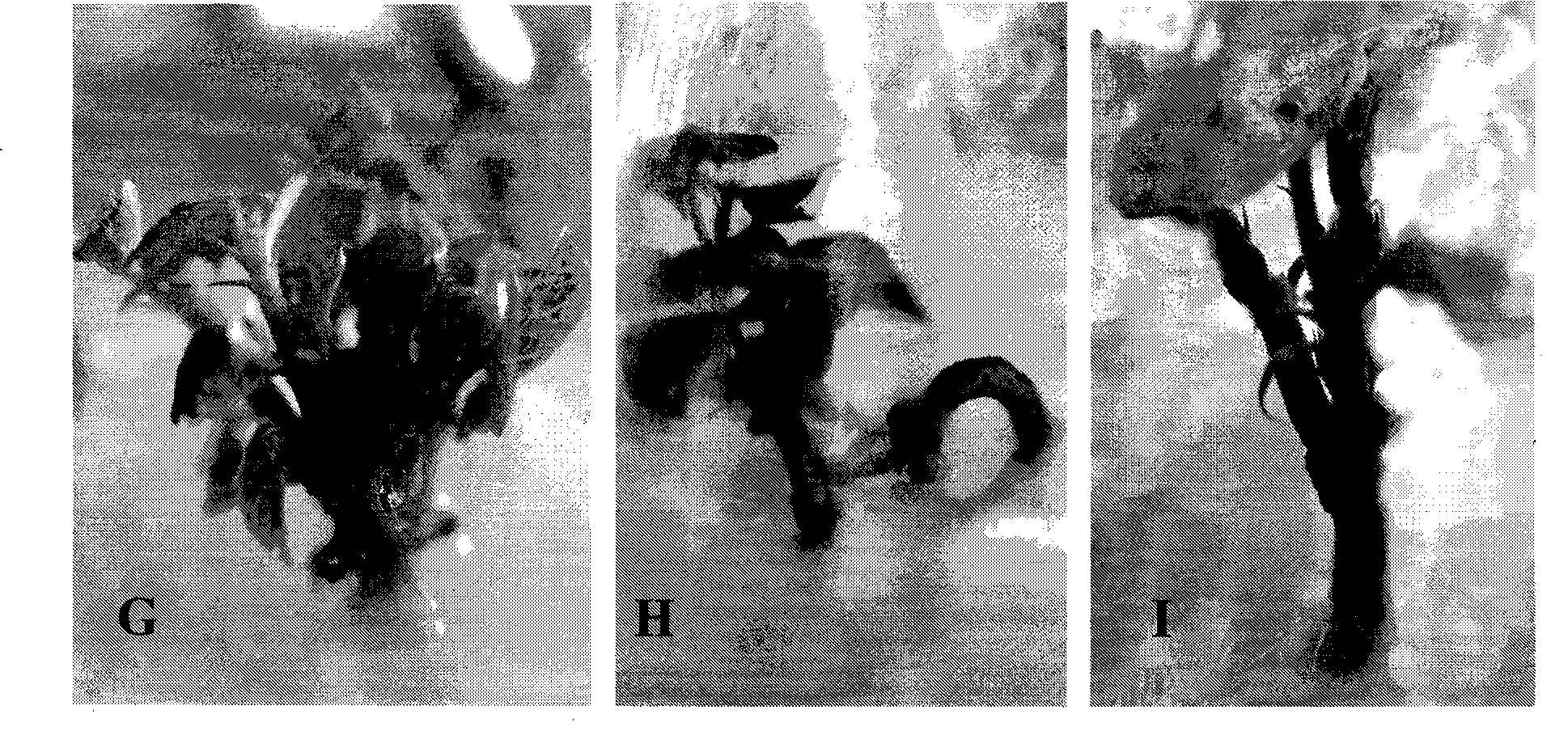Direct polygerm-generation regeneration plant culture method by isolated culture of Xinjiang snow locus epicotyl
A technology of in vitro culture and culture method, which is applied in the field of cotton epicotyl in vitro culture and direct multi-bud regeneration plants, which can solve the problems of low rooting efficiency, browning of explants, high deformity rate, etc., and achieve regenerated buds Robust, easy to survive after transplanting, and slow down the effect of browning
- Summary
- Abstract
- Description
- Claims
- Application Information
AI Technical Summary
Problems solved by technology
Method used
Image
Examples
Embodiment 1
[0048] Example 1: Method for in vitro culture of sea island cotton epicotyls for direct multi-budding regenerated plants and decapitated epicotyl explants
[0049] The seeds of sea island cotton variety Xinhai No. 19 were obtained by dehulling treatment with sulfuric acid. The seeds were first surface-sterilized with 70% ethanol for 30 sec, followed by 15% hydrogen peroxide (H 2 O 2 ) The aqueous solution was sterilized for 2hr., then rinsed with sterilized water for 6 times and soaked in sterilized water. After 12 to 36hr., the water was drained and the seed coat was extruded. From 1 to 3 days, the cotyledons and the hypocotyls and radicles 4 to 6 mm below the cotyledon nodes are cut off and discarded, and the remaining part is the epicotyl explants. Make a slit of 0.3-0.7 mm longitudinally at the top of the epicotyl explant, do not split the hypocotyl, and then insert the multi-bud induction medium (MS salt + B 5 In organic+6-BA0.0~0.8mg / l+NAA0~0.06mg / l+glucose 30g / l), mu...
Embodiment 2
[0050] Example 2: Method for direct multi-budding regenerated plants by in vitro culture of upland cotton epicotyls and decapitated epicotyl explants
[0051] The seeds of the early-maturing upland cotton variety Xinluzao No. 17 were obtained by defibrating with sulfuric acid. The seeds were first surface-sterilized with 70% ethanol for 30 sec, followed by 15% hydrogen peroxide (H 2 O 2 ) The aqueous solution was sterilized for 2 hr., then rinsed with sterilized water for 5 times and soaked in sterilized water. After 36 to 48 hr., the water was drained and the seed coat was extruded. On 2-5 days, the cotyledons and the hypocotyls and radicles 6-10mm below the cotyledon nodes were cut off and discarded, and the remaining part was the epicotyl explants. Make a slit of 0.7-1.3 mm longitudinally at the top of the epicotyl explant, do not split the hypocotyl, and then insert the multi-bud induction medium (MS salt + B 5 Organic+6-BA0.8~1.3mg / l+NAA
[0052] 0.07~1.0mg / l+glucose ...
Embodiment 3
[0053] Example 3: Method for in vitro culture of epicotyl of Xintianzhi No. 1 and direct multi-budding regeneration plant and decapitated epicotyl explants
[0054] The seeds of Xintianzhi No. 1 were smashed with force and the seed coat was gently smashed to remove the seed kernels. The surface was first disinfected with 70% ethanol for 30 sec, then sterilized with 0.1% mercuric solution for 10 minutes, and then rinsed with sterilized water for 6 times. The kernels were inoculated on 1 / 2MS solid medium and cultivated in a lighted place, and the cotyledons, the hypocotyls and radicles 6-10mm below the cotyledon nodes were cut from the sterile seedlings cultivated for 5-7 days and discarded. Epicotyl explants, on which the embryos were cut with a small gap, were transferred to inducing multi-budding medium (MS salt + B5 In organic+6-BA0.1~0.5mg / l+NAA0.5~1.5mg / l+glucose 30g / l), many buds were seen after culturing for 20 days. After culturing the epicotyl explants that did not pro...
PUM
 Login to View More
Login to View More Abstract
Description
Claims
Application Information
 Login to View More
Login to View More - R&D
- Intellectual Property
- Life Sciences
- Materials
- Tech Scout
- Unparalleled Data Quality
- Higher Quality Content
- 60% Fewer Hallucinations
Browse by: Latest US Patents, China's latest patents, Technical Efficacy Thesaurus, Application Domain, Technology Topic, Popular Technical Reports.
© 2025 PatSnap. All rights reserved.Legal|Privacy policy|Modern Slavery Act Transparency Statement|Sitemap|About US| Contact US: help@patsnap.com



